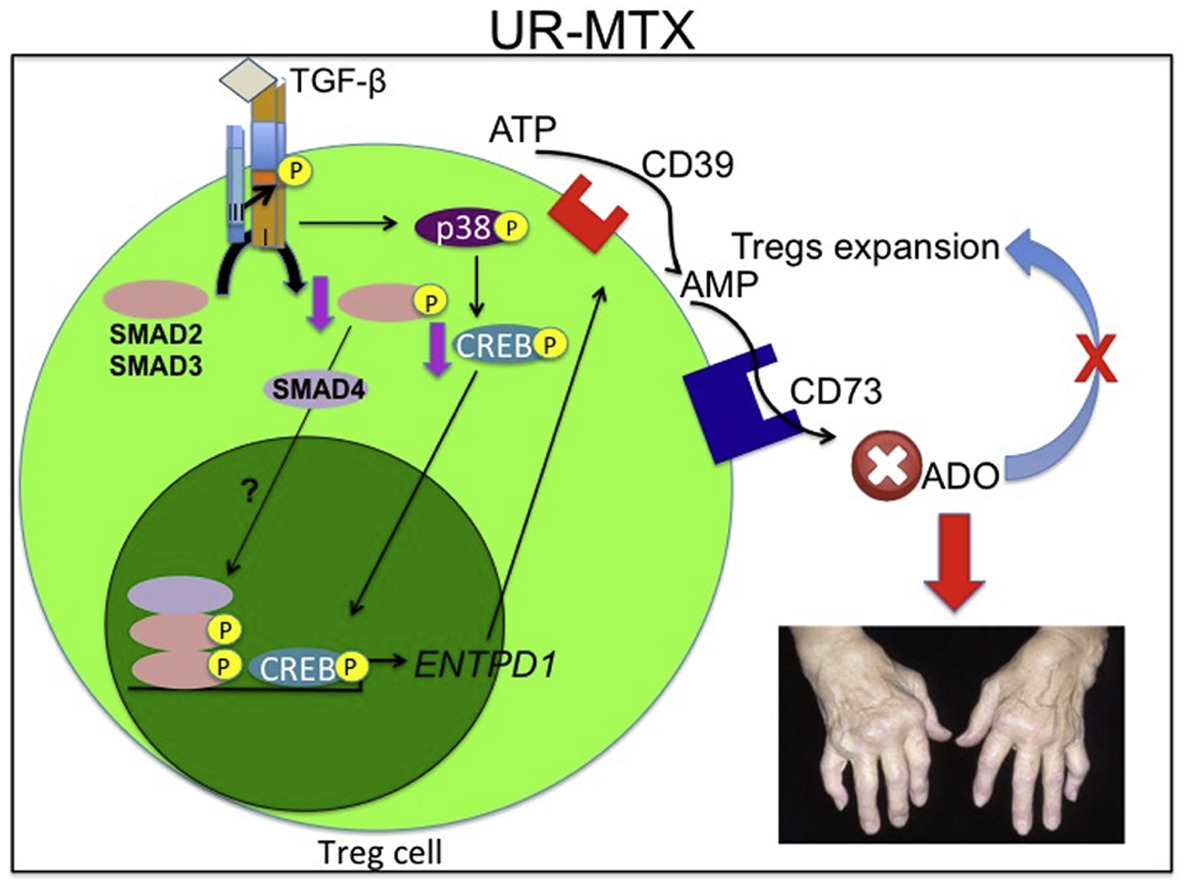TGF-β signalling defect is linked to low CD39 expression on regulatory T cells and methotrexate resistance in rheumatoid arthritis.
Rheumatoid arthritis (RA) is an autoimmune arthropathy characterized by chronic articular inflammation. Methotrexate (MTX) remains the first-line therapy for RA and its anti-inflammatory effect is associated with the maintenance of high levels of extracellular adenosine (ADO). Nonetheless, up to 40% of RA patients are resistant to MTX treatment and this is linked to a reduction of CD39 expression, an ectoenzyme involved in the generation of extracellular ADO by ATP metabolism, on circulating regulatory T cells (Tregs). However, the mechanism mediating the reduction of CD39 expression on Tregs is unknown. Here we demonstrated that the impairment in TGF-β signalling lead to the reduction of CD39 expression on Tregs that accounts for MTX resistance. TGF-β increases CD39 expression on Tregs via the activation of TGFBRII/TGFBRI, SMAD2 and the transcription factor CREB, which is activated in a p38-dependent manner and induces CD39 expression by promoting ENTPD1 gene transcription. Importantly, unresponsive patients to MTX (UR-MTX) show reduced expression of TGFBR2 and CREB1 and decreased levels of p-SMAD2 and p-CREB in Tregs compared to MTX-responsive patients (R-MTX). Furthermore, RA patients carrying at least one mutant allele for rs1431131 (AT or AA) of the TGFBR2 gene are significantly (p = 0.0006) associated with UR-MTX. Therefore, we have uncovered a molecular mechanism for the reduced CD39 expression on Tregs, and revealed potential targets for therapeutic intervention for MTX resistance.
Authors
Raphael S Peres; Paula B Donate; Jhimmy Talbot; Nerry T Cecilio; Patricia R Lobo; Caio C Machado; Kalil W A Lima; Rene D Oliveira; Vanessa Carregaro; Helder I Nakaya; Thiago M Cunha; José Carlos Alves-Filho; Foo Y Liew; Paulo Louzada-Junior; Fernando Q Cunha
External link
Publication Year
Publication Journal
Associeted Project
Microbiology or Immunology
Lista de serviços
-
Gene regulatory and signaling networks exhibit distinct topological distributions of motifs.Gene regulatory and signaling networks exhibit distinct topological distributions of motifs.
-
Gene signatures of autopsy lungs from obese patients with COVID-19.Gene signatures of autopsy lungs from obese patients with COVID-19.
-
Network Medicine: Methods and ApplicationsNetwork Medicine: Methods and Applications
-
ACE2 Expression Is Increased in the Lungs of Patients With Comorbidities Associated With Severe COVID-19.ACE2 Expression Is Increased in the Lungs of Patients With Comorbidities Associated With Severe COVID-19.
-
Drug repositioning for psychiatric and neurological disorders through a network medicine approach.Drug repositioning for psychiatric and neurological disorders through a network medicine approach.
-
Linking proteomic alterations in schizophrenia hippocampus to NMDAr hypofunction in human neurons and oligodendrocytes.Linking proteomic alterations in schizophrenia hippocampus to NMDAr hypofunction in human neurons and oligodendrocytes.
-
In-depth analysis of laboratory parameters reveals the interplay between sex, age, and systemic inflammation in individuals with COVID-19.In-depth analysis of laboratory parameters reveals the interplay between sex, age, and systemic inflammation in individuals with COVID-19.
-
The evolution of knowledge on genes associated with human diseasesThe evolution of knowledge on genes associated with human diseases
-
Network vaccinology.Network vaccinology.
-
Pyruvate kinase M2 mediates IL-17 signaling in keratinocytes driving psoriatic skin inflammationPyruvate kinase M2 mediates IL-17 signaling in keratinocytes driving psoriatic skin inflammation
-
Transcriptome analysis of six tissues obtained post-mortem from sepsis patientsTranscriptome analysis of six tissues obtained post-mortem from sepsis patients
-
Gene Signatures of Symptomatic and Asymptomatic Clinical-Immunological Profiles of Human Infection by Leishmania (L.) chagasi in Amazonian BrazilGene Signatures of Symptomatic and Asymptomatic Clinical-Immunological Profiles of Human Infection by Leishmania (L.) chagasi in Amazonian Brazil
-
In vitro morphological profiling of T cells predicts clinical response to natalizumab therapy in patients with multiple sclerosis.In vitro morphological profiling of T cells predicts clinical response to natalizumab therapy in patients with multiple sclerosis.
-
Integrative immunology identified interferome signatures in uveitis and systemic disease-associated uveitis.Integrative immunology identified interferome signatures in uveitis and systemic disease-associated uveitis.
-
Gene regulatory networks analysis for the discovery of prognostic genes in gliomas.Gene regulatory networks analysis for the discovery of prognostic genes in gliomas.
-
Revealing shared molecular drivers of brain metastases from distinct primary tumors.Revealing shared molecular drivers of brain metastases from distinct primary tumors.

